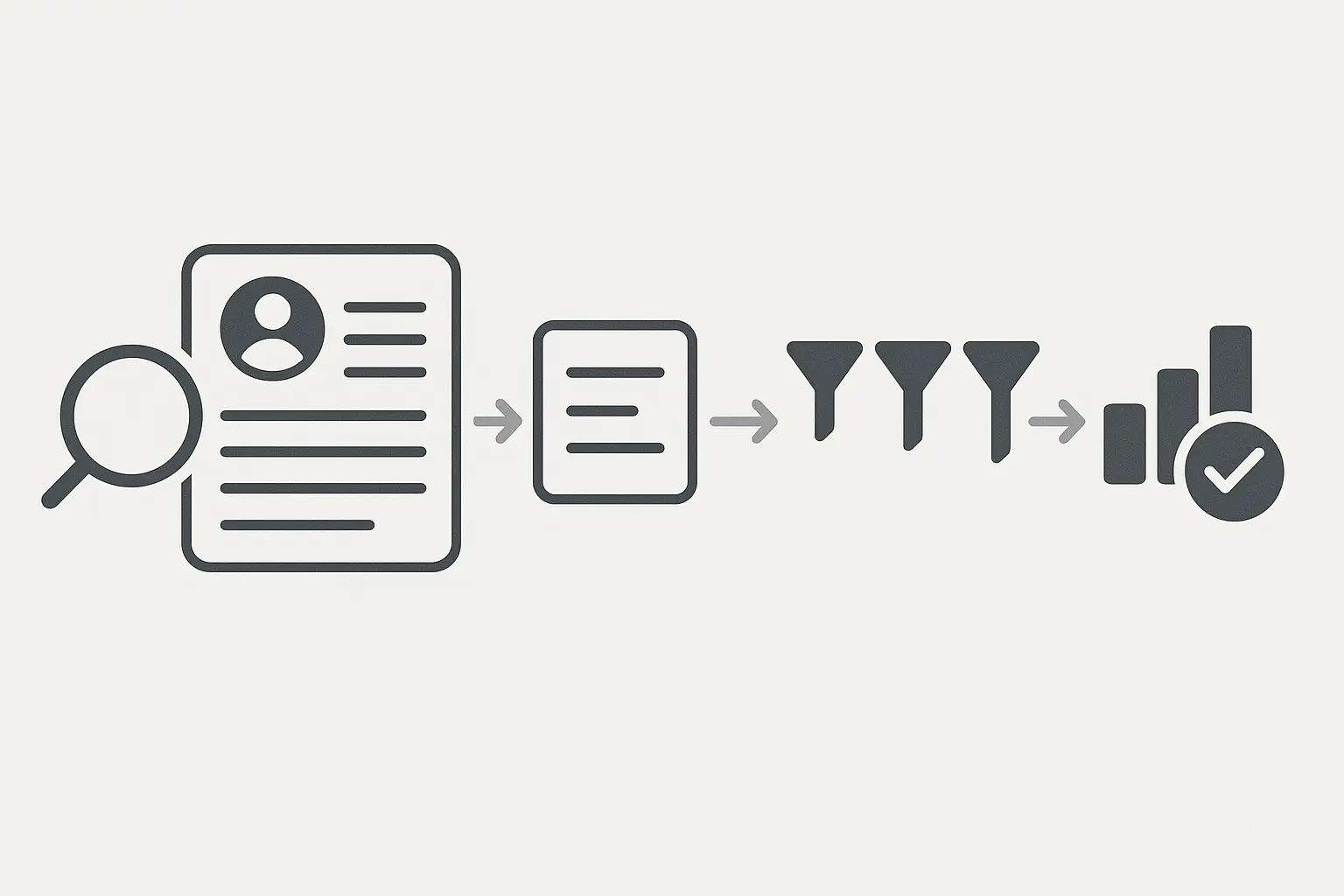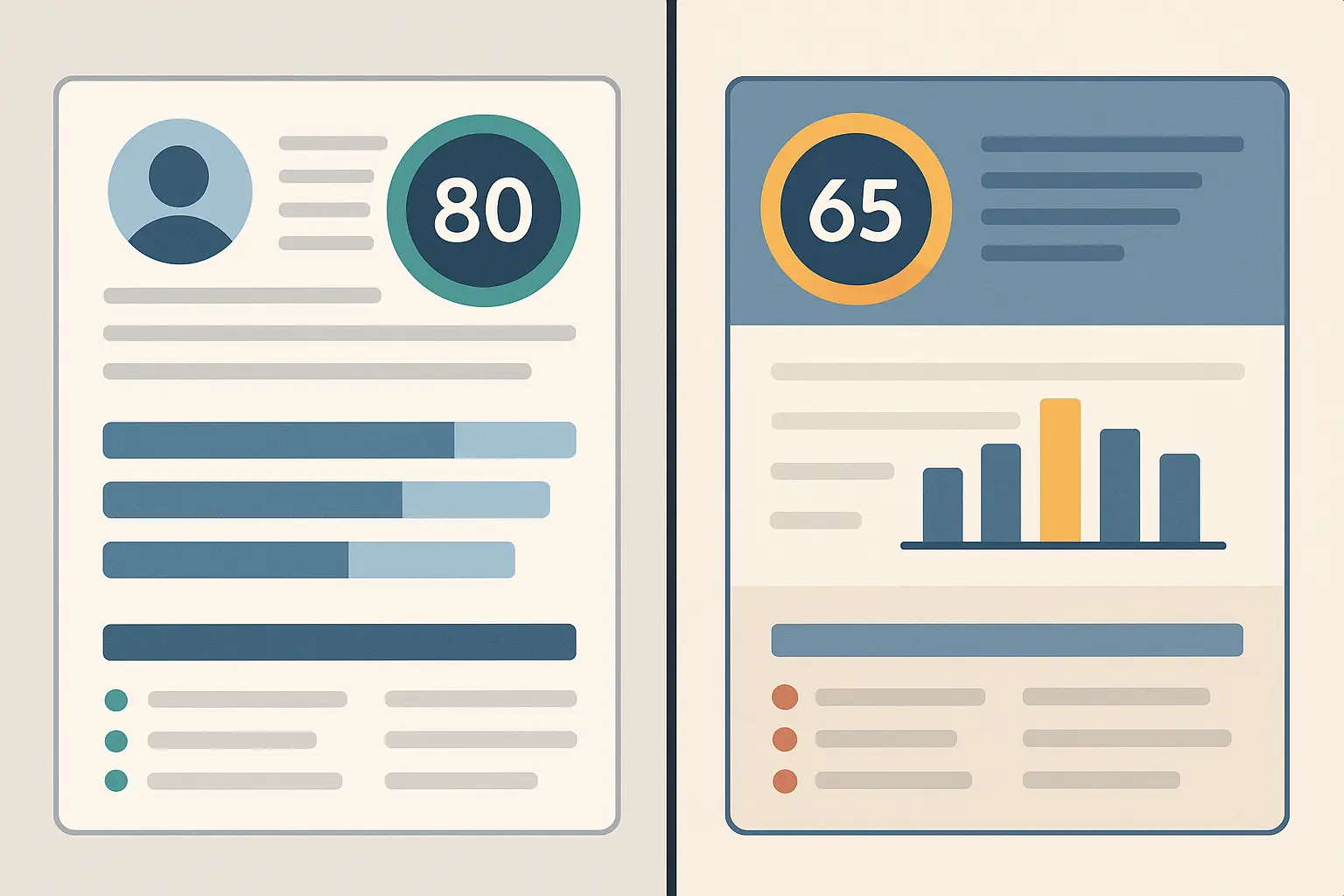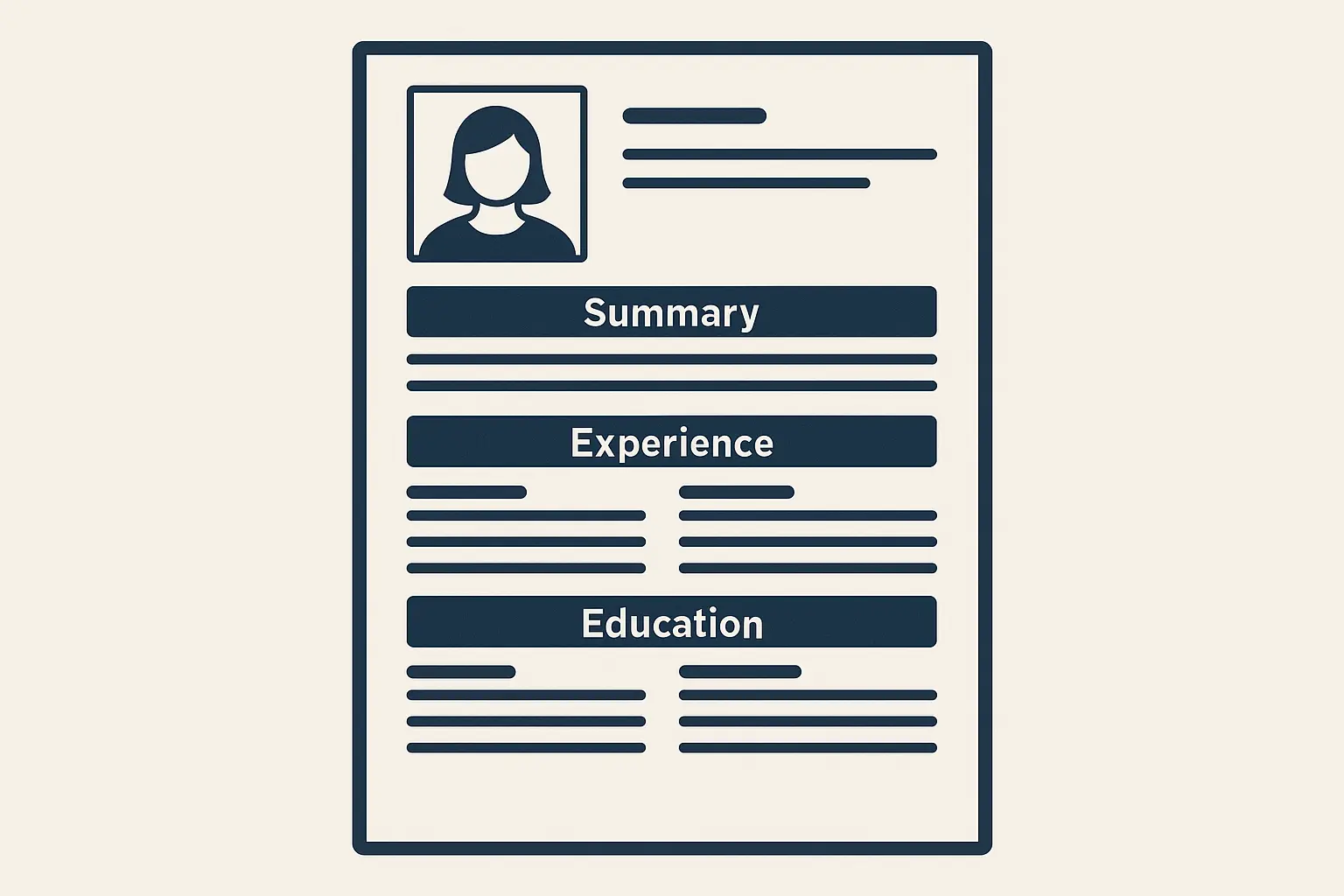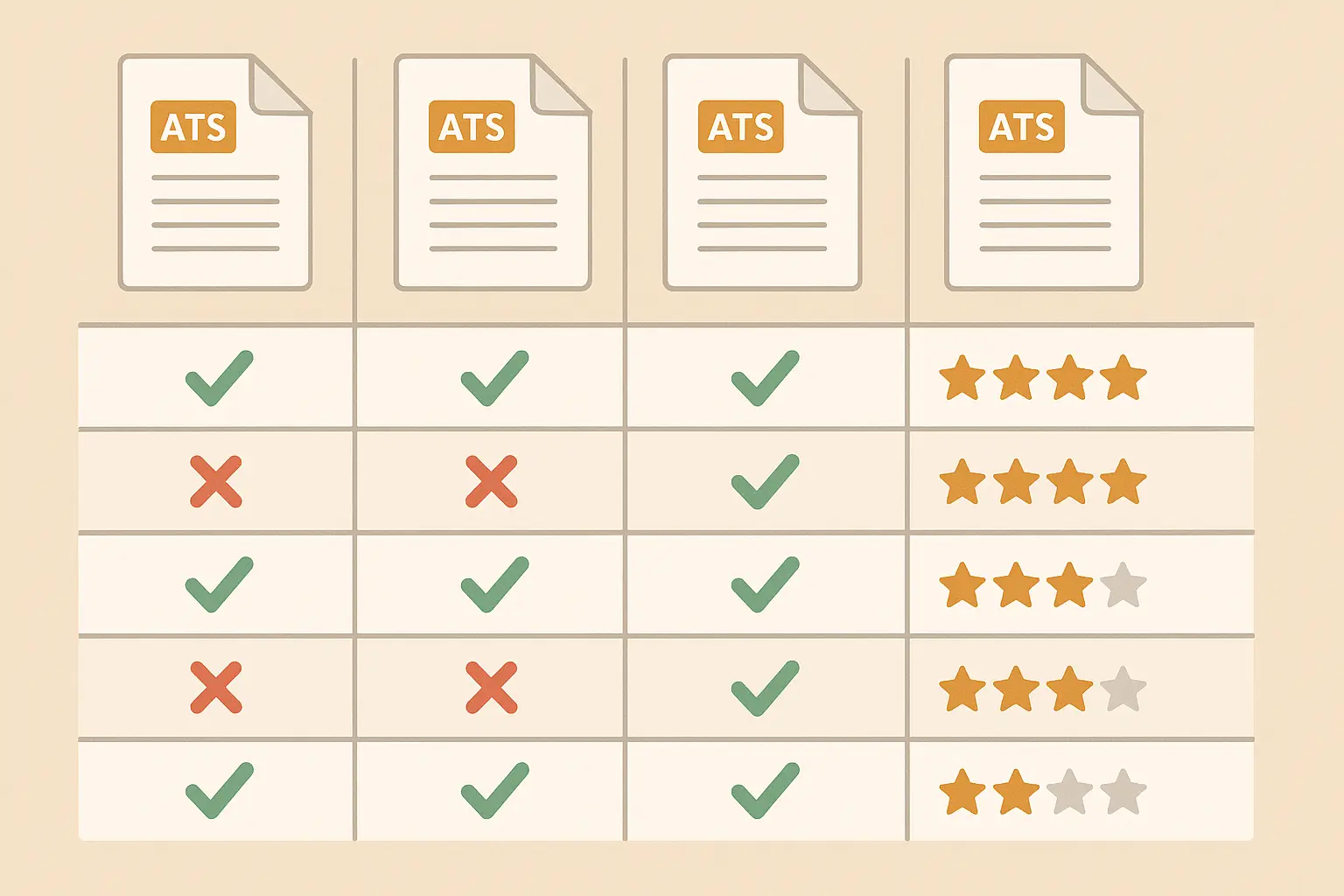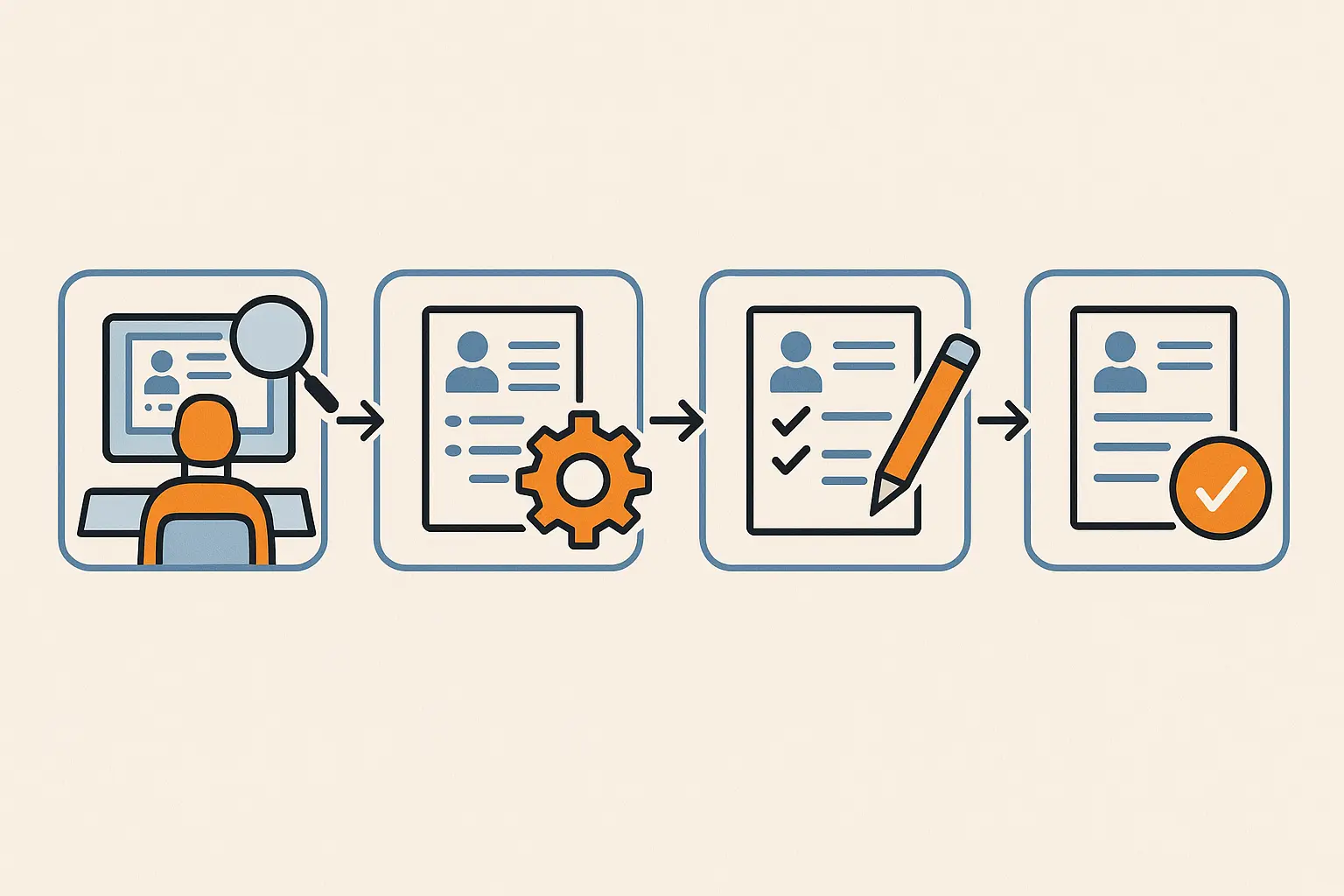ATS Resume Checker: Why Your Perfect Resume Gets Rejected (And How to Fix It)

TL;DR
- ATS systems automatically filter out 75% of job applications before humans see them
- Poor formatting, missing keywords, and wrong file types cause most rejections
- Jobscan leads the market for comprehensive analysis, while free tools handle basic scanning
- Strategic keyword use means analyzing job descriptions and weaving terms naturally into your content
- Match scores above 75% significantly boost your chances of passing automated screening
- Different industries and companies use varying ATS platforms, requiring tailored approaches
- Continuous testing and tweaking ensure optimal performance across multiple applications
Understanding ATS Resume Checkers and Their Impact
Ever wonder why your perfectly crafted resume seems to disappear into a black hole? Here’s the brutal truth: machines are rejecting you before any human even glances at your qualifications.
Most companies now use Applicant Tracking Systems (ATS) to filter resumes automatically, which is why using an ATS resume checker has become an essential step before applying. These systems scan your document for specific keywords, formatting, and criteria. If you don’t pass their digital test, you’re out—no matter how qualified you are.
The numbers are staggering. 99% of Fortune 500 companies use Applicant Tracking Systems (ATS) to process resumes, and according to Jobscan’s research, their job search tools can increase your interview chances by 50%. I’ve seen this transformation firsthand—professionals who optimize their resumes properly suddenly start getting callbacks after months of silence.
What Happens When Your Resume Hits an ATS System
When you hit “submit” on that job application, your resume doesn’t land on a hiring manager’s desk. Instead, it gets fed through software that scans, parses, and ranks your document against specific criteria. This process determines whether your application moves forward or gets automatically tossed.
The technology uses keyword matching algorithms, formatting analysis, and content parsing to create a score that influences your application’s fate. Your carefully crafted resume gets dissected by algorithms that don’t care about your personality or potential—they only understand data points and matching criteria.
The Cold Reality of Automated Rejection
Most job seekers don’t realize that their beautifully designed resumes might be getting rejected by machines. I’ve reviewed hundreds of resumes that looked impressive to me but scored poorly on ATS checker tools.
Common rejection factors include poor formatting that confuses parsing algorithms—something an ATS resume checker can quickly identify before you submit your application. Understanding these pitfalls helps you avoid the frustration of sending applications into a digital black hole.
This is where understanding the fundamentals of professional resume formatting becomes crucial for ATS compatibility.
Balancing Machine Requirements with Human Appeal
The challenge isn’t just satisfying algorithmic requirements—your resume still needs to impress human recruiters once it passes the ATS screening. This creates a dual optimization challenge where you must craft content that performs well in automated systems while remaining engaging and readable for actual people.
The best resumes achieve this balance through strategic formatting and natural keyword integration. The most successful candidates master this dual approach rather than focusing solely on one aspect.
How Modern ATS Technology Actually Processes Your Resume
ATS checkers work by replicating the scanning process used by actual hiring systems. They analyze your document’s structure, extract relevant information, and compare it against job requirements to generate compatibility scores.
This analysis covers everything from keyword density and placement to formatting compatibility and section organization, providing detailed feedback on areas that need improvement. The sophistication of these tools has improved dramatically over the past few years.
Recent testing by job search experts reveals concerning trends in AI-powered resume optimization. As reported by “Success Magazine”, while seven in 10 companies plan to use some form of AI within the hiring process by the end of 2025, many AI optimization tools show suspicious patterns where scores remain artificially low to encourage premium subscriptions.
The Science Behind Keyword Analysis
Effective ATS checkers don’t just count keywords—they analyze context, relevance, and strategic placement throughout your resume. These tools compare your content against job descriptions to identify missing industry-specific terms and suggest where to incorporate them naturally.
The goal isn’t keyword stuffing but rather ensuring your qualifications are communicated in language that ATS systems recognize and value. I’ve seen too many resumes that read awkwardly because someone tried to cram in every possible keyword without considering flow or readability.
How ATS Resume Checkers Actually Work Behind the Scenes
Think of ATS systems like really picky readers. They get confused by fancy fonts, weird layouts, or graphics. Understanding how these systems work helps you make better optimization decisions and avoid common pitfalls that trip up even qualified candidates.
I’ve spent considerable time testing different platforms to understand their methodologies. The best tools simulate the multi-step process that actual hiring systems use to evaluate applications.
The Technical Process of Resume Scanning
ATS checkers simulate the multi-step process that actual hiring systems use to evaluate applications. First, they parse your document to extract text and identify different sections. Then they analyze formatting compatibility, checking whether the structure can be properly read by various ATS platforms.
Finally, they perform content analysis, comparing your qualifications against job requirements and generating actionable recommendations for improvement. This comprehensive process reveals why some resumes perform better than others in automated systems.
Document Parsing and Information Extraction
The parsing phase determines whether an ATS can properly extract information from your resume. Checkers evaluate how well your formatting translates across different systems, identifying potential issues with complex layouts, unusual fonts, or embedded graphics that might cause parsing errors.
This technical analysis helps ensure your carefully crafted content doesn’t get lost in translation. I’ve seen resumes with impressive content score poorly simply because the formatting confused the parsing algorithms.
| ATS Parsing Element | Compatible Format | Problematic Format |
|---|---|---|
| File Type | .docx, PDF | .jpg, .png, .txt |
| Font Selection | Arial, Calibri, Times New Roman | Decorative fonts, Script fonts |
| Layout Structure | Single column, Clear sections | Multi-column, Text boxes |
| Graphics Usage | Minimal or none | Heavy graphics, Images |
| Header/Footer | Standard contact info | Complex designs, Logos |
Scoring Algorithms and Ranking Systems
Most ATS platforms assign numerical scores to resumes based on multiple factors including keyword matches, experience relevance, and formatting quality. Understanding these scoring systems helps you prioritize optimization efforts, and testing with an ATS resume checker gives you a clear benchmark for improvement.
Match percentages above 75% generally indicate strong ATS compatibility, while lower scores suggest significant improvements are needed to compete effectively. Research from Jobscan indicates that they recommend a match rate score of 75%, though many career counselors and users see success even with just a 65% match rate.
Your resume doesn’t need to achieve perfection—it needs to perform well enough to make it past the initial screening. I’ve seen candidates with 68% match rates land interviews while others with 85% scores get rejected, proving that optimization is just one piece of the puzzle.
Popular ATS Resume Checker Tools You Should Know About
Before diving into specific tools, it’s important to understand that an ATS resume checker is essentially a simulator that mimics how hiring systems read and rank your application.
The market offers various ATS checking solutions, each with different strengths, features, and pricing structures. Choosing the right tool depends on your specific needs, budget, and career goals. Some platforms excel in keyword analysis while others focus on formatting compatibility or industry-specific optimization.
I’ve tested most of the major platforms available today. Jobscan consistently delivers the most comprehensive analysis, though several other tools offer valuable features for different situations.
Jobscan: The Gold Standard for ATS Analysis
Jobscan has established itself as the leading platform for comprehensive ATS optimization. It provides detailed compatibility reports, keyword optimization suggestions, and job-specific tailoring recommendations that go beyond basic scanning.
The platform’s sophisticated analysis capabilities make it a preferred choice for serious job seekers who want thorough optimization guidance. Jobscan doesn’t just tell you what’s wrong—it explains why certain changes matter and how to implement them effectively.
What Makes Jobscan Different
Jobscan’s strength lies in its detailed analysis approach and extensive database of ATS system behaviors. The platform provides specific recommendations for keyword placement, identifies skill gaps, and offers formatting suggestions calibrated to major ATS platforms used by Fortune 500 companies.
However, its premium pricing and focus on certain industries might not suit every job seeker’s needs. Jobscan works best for professionals in competitive fields where detailed optimization can make the difference between getting an interview and being overlooked.
Getting the Most from Jobscan’s Features
Maximizing Jobscan’s value requires understanding how to use its various analysis tools effectively. Upload your resume and target job descriptions to generate detailed match reports. Pay attention to the skill recommendations and keyword suggestions, but don’t blindly implement every suggestion—maintain natural language flow while incorporating relevant terms strategically.
Jobscan excels at identifying subtle optimization opportunities that other tools miss. I’ve found their industry-specific insights particularly valuable for professionals transitioning between fields or targeting specialized roles.
Take Sarah, a marketing pro I know. She couldn’t figure out why she wasn’t getting callbacks despite five years of solid experience. Using Jobscan, she discovered her resume scored only 45% against a digital marketing manager position. The analysis revealed she was missing basic terms like “conversion optimization,” “marketing automation,” and “A/B testing”—stuff she did every day but never thought to explicitly mention. After strategically incorporating these terms into existing experience descriptions, her match rate improved to 78%, leading to three interview requests within two weeks.
Free vs. Premium ATS Checker Options
Budget-conscious job seekers can access basic ATS checking through free platforms, though these tools typically offer limited analysis compared to premium services. Free checkers provide valuable insights for identifying major issues, but they lack the depth and industry-specific guidance that premium tools offer.
According to recent analysis by “eWeek”, AI-powered resume builders are being used by over three million job seekers worldwide, with many platforms now focusing on content optimization rather than just design, incorporating features such as AI bullet point writers and real-time content analysis.
Making Free Tools Work for You
Free tools can be surprisingly effective when used strategically. Test your resume across multiple free platforms to identify consistent issues and prioritize improvements based on frequency of mentions.
While these tools won’t provide the comprehensive analysis of premium services, they offer a solid starting point for optimization efforts. I recommend using free tools to identify obvious problems before investing in premium analysis for fine-tuning.
When to Invest in Premium Features
Premium ATS checkers become worthwhile when you’re applying to competitive positions, changing industries, or struggling to get interviews despite having strong qualifications. The best tools justify their cost through detailed analysis, industry-specific insights, and ongoing optimization support for serious job seekers who need every advantage in their search.
| Tool Category | Features | Best For | Price Range |
|---|---|---|---|
| Free Basic | Keyword scanning, Basic formatting check | Entry-level positions, Initial optimization | $0 |
| Free Premium | Limited advanced analysis, Basic suggestions | Mid-level professionals, Budget-conscious users | $0 |
| Paid Standard | Comprehensive analysis, Industry insights | Competitive positions, Career changers | $29-49/month |
| Paid Premium | Full optimization suite, Ongoing support | Executive roles, Specialized industries | $79-129/month |
Essential Formatting Rules That Make or Break Your Application
Proper formatting ensures your resume can be accurately parsed by ATS software, and running it through an ATS resume checker helps confirm that nothing critical gets lost in translation. Many qualified candidates get filtered out simply because their resume formatting confuses automated systems, making this one of the most critical aspects of ATS optimization.
I’ve reviewed resumes from incredibly qualified professionals who couldn’t understand why they weren’t getting interviews. Nine times out of ten, the problem was formatting that looked great to humans but completely confused the parsing algorithms.
File Format and Structure Requirements
ATS systems perform best with standard file formats such as PDF or Word documents that follow conventional resume structures. Using clear headings, logical information hierarchy, and standard section names helps ensure your content gets properly categorized and analyzed.
Avoid creative formats that might look impressive to humans but confuse automated parsing systems. Your resume needs to prioritize functionality over flashy design elements that can derail the scanning process.
The Technical Side of ATS-Friendly Formatting
Simple fonts, adequate white space, and minimal graphics ensure maximum compatibility across different ATS platforms while maintaining professional appearance. Stick to standard fonts such as Arial, Calibri, or Times New Roman, and avoid complex formatting elements such as text boxes, tables, or embedded images that can cause parsing errors.
Creating ATS-compatible resumes means sacrificing some visual flair for functional reliability. According to Enhancv’s testing, resumes that score higher than 80 on their checker are considered mostly good, with their system evaluating 16 crucial checks across 5 different categories including content, file type, and keywords.
Typography and Design Considerations
While creativity in resume design can help you stand out to human recruiters, ATS systems prefer simplicity and consistency. Focus on clean, readable layouts that clearly separate different sections and use standard formatting conventions.
Remember, your resume needs to pass the ATS screening before anyone can appreciate your design choices. I’ve learned this lesson the hard way after seeing beautiful resumes get rejected by automated systems.
Balancing Visual Appeal with ATS Compatibility
You don’t have to sacrifice all visual appeal for ATS compatibility. Strategic use of bold text for headings, consistent bullet points, and proper spacing can create an attractive document that still performs well in automated systems.
The key is understanding which design elements enhance readability versus those that create parsing problems. Your resume can look professional and polished while still meeting technical requirements.
ATS-Friendly Formatting Checklist:
- Use standard fonts (Arial, Calibri, Times New Roman)
- Save as .docx or PDF format
- Avoid headers and footers
- Use standard section headings
- Maintain single-column layout
- Include adequate white space
- Avoid graphics and images
- Use consistent bullet points
- Spell out acronyms with full forms
- Proofread for spelling and grammar errors
Strategic Keyword Integration That Actually Works
Effective keyword optimization goes beyond simply stuffing your resume with industry terms. It requires research, strategic placement, and natural integration of relevant keywords that match job requirements without compromising readability or authenticity.
I’ve seen too many resumes that read awkwardly because someone tried to game the system with obvious keyword stuffing. The best tools can actually detect this and penalize resumes that sacrifice readability for keyword density.
Job Description Analysis Methods
Systematic analysis of target job postings helps identify critical keywords, required skills, and industry terminology that should appear in your resume. Don’t just focus on obvious technical skills—pay attention to soft skills, industry-specific terms, and company culture keywords that might influence ATS scoring.
Tools work best when you provide them with specific job descriptions to analyze against your resume. This targeted approach yields much better results than generic optimization.
Building Your Keyword Database
Create a comprehensive keyword database by analyzing 5-10 similar job descriptions in your target field. Organize terms by category (technical skills, soft skills, industry terms, certifications) and note their frequency across different postings.
This research forms the foundation for strategic keyword integration throughout your resume. I spend considerable time on this research phase because it directly impacts optimization effectiveness.
Here’s what worked for Mike, a software engineer I helped: He analyzed 8 job postings for senior developer roles and identified recurring keywords: “React,” “Node.js,” “Agile methodology,” “CI/CD pipelines,” and “cloud architecture.” Instead of simply listing these terms, he integrated them naturally: “Led development of React-based applications using Node.js backend, implementing CI/CD pipelines within Agile methodology frameworks to deploy cloud architecture solutions.”
Natural Keyword Placement Strategies
Keywords should be woven naturally into your experience descriptions, skills sections, and professional summary rather than artificially stuffed into content. The goal is communicating your qualifications in language that both ATS systems and human recruiters recognize and value.
Tools can identify when keyword integration feels forced or unnatural. The most effective optimization maintains authentic voice while incorporating necessary terminology strategically throughout the document.
Industry-Specific Optimization Approaches
Different industries prioritize different types of keywords, requiring tailored approaches for technical roles versus creative positions. Tech roles might emphasize programming languages and methodologies, while marketing positions focus on campaign types and analytical tools.
Understanding these nuances helps you optimize effectively for your specific field. For professionals transitioning between industries, understanding how to tailor your approach becomes even more critical, especially when preparing for banking interview questions where financial terminology and compliance keywords are essential.
Advanced ATS Optimization Strategies for Competitive Edge
Beyond basic formatting and keywords, advanced optimization involves understanding ATS ranking algorithms, tailoring approaches for specific industries, and implementing sophisticated content strategies that give you a competitive advantage in automated screening processes.
Premium tools provide insights into these advanced strategies, but implementing them effectively requires understanding the underlying principles. I’ve discovered that the most successful candidates go beyond surface-level optimization to create truly strategic approaches.
Understanding ATS Ranking and Scoring Systems
Most ATS platforms use complex algorithms to rank resumes based on multiple factors including keyword relevance, experience alignment, and formatting quality. Understanding these systems helps you prioritize optimization efforts and focus on changes that will have the greatest impact on your application’s performance.
Jobscan provides detailed breakdowns of how different factors contribute to your overall score. Tools that offer this level of transparency help you make informed decisions about where to invest your optimization efforts.
Decoding Match Percentages and Scores
ATS checkers typically provide match percentages indicating how well your resume aligns with job requirements. Scores above 75% generally indicate strong compatibility, while lower percentages suggest significant optimization is needed.
However, don’t obsess over achieving perfect scores—focus on meaningful improvements that accurately represent your qualifications. Jobscan research shows that even modest improvements in match rates can significantly impact interview callback rates.
Tailoring Strategies for Different Applications
Successful job seekers maintain multiple resume versions optimized for different roles, industries, or companies. This approach allows for targeted optimization while maintaining consistency in your core qualifications and experience presentation.
Processes become more efficient when you develop systematic approaches to customization rather than starting from scratch for each application.
Creating Master Resume Templates
Develop comprehensive master resumes with extensive keyword libraries that allow for efficient customization while maintaining consistency across applications. This approach saves time while ensuring each application is properly optimized for specific requirements and ATS systems.
Users often develop template libraries that can be quickly adapted for different opportunities, maximizing their optimization efficiency.
Master Resume Template Components:
- Core professional summary with variable keywords
- Comprehensive skills section organized by category
- Detailed experience descriptions with keyword variations
- Education and certification sections with relevant terms
- Industry-specific achievement examples
- Technical proficiency listings
Company-Specific ATS Considerations
Different companies use various ATS platforms with unique parsing capabilities and ranking criteria. When possible, research the specific systems used by target employers to tailor your optimization approach accordingly.
This level of customization can provide a significant advantage in competitive application processes. Tools that account for platform-specific differences offer more accurate optimization guidance. Jobscan maintains databases of ATS platform behaviors that inform their recommendations.
Understanding salary expectations for your target roles, such as certified pharmacy tech salary ranges or physician assistant compensation, helps you position yourself appropriately within industry standards.
Choosing the Best ATS Resume Checker for Your Situation
With numerous options available, selecting the right tool depends on your career level, industry requirements, budget constraints, and specific optimization goals. Understanding the strengths and limitations of different platforms helps you make an informed decision that maximizes your investment.
Jobscan dominates the premium market, but several other tools offer valuable features for specific situations. I’ve tested most major platforms to understand their unique value propositions.
Evaluating ATS Checker Effectiveness
The best tools provide accurate scanning algorithms, comprehensive feedback, and actionable recommendations that translate into measurable improvements in application success rates. Look for tools that offer consistent results across multiple scans and align closely with actual ATS system behavior.
Jobscan consistently demonstrates superior accuracy in my testing, though other platforms excel in specific areas such as formatting analysis or industry-specific optimization.
Accuracy and Reliability Metrics
Top-tier ATS checkers demonstrate consistent performance and provide feedback that correlates with real-world application success. Test potential tools with the same resume to compare their analysis quality and recommendation consistency.
Reliable platforms should identify similar issues and provide comparable optimization suggestions. Jobscan typically provides the most detailed and actionable feedback, while other tools might excel in specific analysis areas.
Feature Comparison Framework
Effective evaluation requires comparing keyword analysis depth, formatting feedback quality, industry-specific insights, and integration capabilities across different platforms. Consider factors such as ease of use, customer support quality, and update frequency when making your decision.
Tools vary significantly in their analytical depth and user experience. Jobscan offers comprehensive analysis but requires more time investment, while simpler tools provide quick feedback for basic optimization needs.
Advanced Features Worth Considering
Premium checkers often include features such as industry-specific optimization, company database integration, and ongoing performance tracking. Evaluate whether these advanced capabilities justify the additional cost based on your specific job search needs and career goals.
Jobscan provides extensive advanced features that benefit serious job seekers, while other platforms might offer specialized capabilities for specific industries or career levels.
A project manager switching from construction to tech used multiple ATS checkers to compare results. While free tools identified basic keyword gaps, premium platforms revealed industry-specific terminology differences and suggested transitioning language such as changing “managed construction teams” to “led cross-functional teams” and “project delivery” to “product delivery,” resulting in a 40% improvement in interview callbacks.
Step-by-Step Implementation Guide That Gets Results
Successful ATS optimization requires a systematic approach that ensures comprehensive coverage of all requirements while maintaining document quality and professional presentation. Following a structured process helps you avoid common mistakes and achieve optimal results efficiently.
Processes work best when implemented systematically rather than randomly. I’ve developed this approach through extensive testing and refinement with hundreds of resumes.
Initial ATS Compatibility Assessment
Begin optimization by running your current resume through multiple tools to establish baseline performance and identify primary improvement areas. Document common issues identified across platforms and create a prioritized improvement list based on potential impact.
Results vary between platforms, so testing with multiple tools provides a more comprehensive assessment of your resume’s current performance.
Setting Up Your Testing Environment
Upload your resume to 2-3 different ATS checker tools to get a comprehensive view of its current performance. Note specific keyword gaps, formatting problems, and compatibility issues that appear consistently across platforms.
This baseline assessment guides your optimization priorities and helps track improvement progress. Tools provide different perspectives on the same document, revealing various optimization opportunities.
Initial Assessment Checklist:
- Test resume with 3 different ATS checkers
- Document baseline scores and percentages
- Identify consistent formatting issues
- Note recurring keyword gaps
- Prioritize improvements by impact potential
- Create optimization timeline
- Set measurable improvement goals
Keyword Research and Integration Process
Systematic keyword research and strategic integration form the foundation of effective ATS optimization. Analyze target job descriptions thoroughly, create organized keyword databases, and implement terms naturally throughout your resume content.
Jobscan excels at this analysis, providing detailed keyword recommendations based on specific job descriptions rather than generic industry terms.
Implementation Steps That Work
Start by analyzing 5-10 target job descriptions to build your keyword database. Organize terms by category and relevance, then map keywords to appropriate resume sections. Integrate terms naturally into existing content, maintaining readability while ensuring proper keyword density.
Test your optimized resume with multiple tools to validate improvements. This iterative approach ensures your changes actually improve performance rather than just changing scores arbitrarily.
Testing and Refinement Cycles
Continuous testing and refinement ensure optimal ATS performance while maintaining resume quality and accuracy. Compare performance metrics against your original version, make incremental adjustments based on feedback, and document successful strategies for future applications.
Processes should be iterative rather than one-time events. Regular testing helps you understand what works for different types of positions and industries.
Measuring Optimization Success
Track your progress using concrete metrics such as match percentages, keyword coverage, and formatting compatibility scores. Make incremental changes rather than wholesale revisions, and always validate that improvements don’t compromise human readability.
Document what works for different types of positions to streamline future optimization efforts. This systematic approach builds your expertise over time.
Optimization Success Metrics:
- Match percentage improvement (target: 75%+)
- Keyword coverage increase
- Formatting compatibility score
- Interview callback rate
- Application response time
- Industry-specific performance variations
Resume Builder IQ addresses these ATS optimization challenges by combining advanced AI technology with expert resume writing knowledge. Rather than struggling with separate tools and manual optimization processes, you can build ATS-friendly resumes from the ground up using our integrated platform. Our AI-powered system ensures natural keyword integration while maintaining professional quality, and our ATS-friendly templates are designed to pass automated screening systems while appealing to human recruiters. Ready to stop worrying about ATS compatibility? Try Resume Builder IQ’s comprehensive solution today.
Final Thoughts
Mastering ATS checkers isn’t about gaming the system—it’s about making sure your actual skills and experience don’t get lost in translation. The investment in proper optimization pays dividends through increased interview opportunities and reduced application frustration.
Remember that ATS optimization is an ongoing process, not a one-time fix. As job requirements evolve and ATS technology advances, your optimization strategies should adapt accordingly. The key is building sustainable processes that allow you to efficiently tailor your resume for different opportunities while maintaining authenticity and professional quality.
Success in today’s job market requires understanding both the technical requirements of automated systems and the human elements of hiring decisions. By mastering these tools and implementing strategic optimization practices, you’re positioning yourself for success in an increasingly competitive landscape where the right approach makes all the difference.
Here’s the bottom line: Fix the technical stuff so humans can see how awesome you really are.
The smartest job seekers make a habit of running every version of their resume through an ATS resume checker to ensure both compatibility and optimization before hitting submit.


